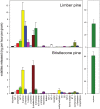Mountain Pine Beetles Use Volatile Cues to Locate Host Limber Pine and Avoid Non-Host Great Basin Bristlecone Pine
- PMID: 26332317
- PMCID: PMC4558103
- DOI: 10.1371/journal.pone.0135752
Mountain Pine Beetles Use Volatile Cues to Locate Host Limber Pine and Avoid Non-Host Great Basin Bristlecone Pine
Abstract
The tree-killing mountain pine beetle (Dendroctonus ponderosae Hopkins) is an important disturbance agent of western North American forests and recent outbreaks have affected tens of millions of hectares of trees. Most western North American pines (Pinus spp.) are hosts and are successfully attacked by mountain pine beetles whereas a handful of pine species are not suitable hosts and are rarely attacked. How pioneering females locate host trees is not well understood, with prevailing theory involving random landings and/or visual cues. Here we show that female mountain pine beetles orient toward volatile organic compounds (VOCs) from host limber pine (Pinus flexilis James) and away from VOCs of non-host Great Basin bristlecone pine (Pinus longaeva Bailey) in a Y-tube olfactometer. When presented with VOCs of both trees, females overwhelmingly choose limber pine over Great Basin bristlecone pine. Analysis of VOCs collected from co-occurring limber and Great Basin bristlecone pine trees revealed only a few quantitative differences. Noticeable differences included the monoterpenes 3-carene and D-limonene which were produced in greater amounts by host limber pine. We found no evidence that 3-carene is important for beetles when selecting trees, it was not attractive alone and its addition to Great Basin bristlecone pine VOCs did not alter female selection. However, addition of D-limonene to Great Basin bristlecone pine VOCs disrupted the ability of beetles to distinguish between tree species. When presented alone, D-limonene did not affect behavior, suggesting that the response is mediated by multiple compounds. A better understanding of host selection by mountain pine beetles could improve strategies for managing this important forest insect. Moreover, elucidating how Great Basin bristlecone pine escapes attack by mountain pine beetles could provide insight into mechanisms underlying the incredible longevity of this tree species.
Conflict of interest statement
Figures




Similar articles
-
Low offspring survival in mountain pine beetle infesting the resistant Great Basin bristlecone pine supports the preference-performance hypothesis.PLoS One. 2018 May 1;13(5):e0196732. doi: 10.1371/journal.pone.0196732. eCollection 2018. PLoS One. 2018. PMID: 29715269 Free PMC article.
-
Defense traits in the long-lived Great Basin bristlecone pine and resistance to the native herbivore mountain pine beetle.New Phytol. 2017 Jan;213(2):611-624. doi: 10.1111/nph.14191. Epub 2016 Sep 9. New Phytol. 2017. PMID: 27612209 Free PMC article.
-
Leap frog in slow motion: Divergent responses of tree species and life stages to climatic warming in Great Basin subalpine forests.Glob Chang Biol. 2018 Feb;24(2):e442-e457. doi: 10.1111/gcb.13881. Epub 2017 Sep 21. Glob Chang Biol. 2018. PMID: 28850759
-
Mountain Pine Beetle Epidemic: An Interplay of Terpenoids in Host Defense and Insect Pheromones.Annu Rev Plant Biol. 2022 May 20;73:475-494. doi: 10.1146/annurev-arplant-070921-103617. Epub 2022 Feb 7. Annu Rev Plant Biol. 2022. PMID: 35130442 Review.
-
Volatile Organic Compounds Emitted by Fungal Associates of Conifer Bark Beetles and their Potential in Bark Beetle Control.J Chem Ecol. 2016 Sep;42(9):952-969. doi: 10.1007/s10886-016-0768-x. Epub 2016 Sep 29. J Chem Ecol. 2016. PMID: 27687998 Free PMC article. Review.
Cited by
-
Volatiles of High-Elevation Five-Needle Pines: Chemical Signatures through Ratios and Insight into Insect and Pathogen Resistance.J Chem Ecol. 2020 Mar;46(3):264-274. doi: 10.1007/s10886-020-01150-0. Epub 2020 Jan 23. J Chem Ecol. 2020. PMID: 31974726
-
Autofluorescence-Based Identification and Functional Validation of Antennal Gustatory Sensilla in a Specialist Leaf Beetle.Front Physiol. 2019 Mar 28;10:343. doi: 10.3389/fphys.2019.00343. eCollection 2019. Front Physiol. 2019. PMID: 31001138 Free PMC article.
-
Constitutive and Induced Defenses in Long-lived Pines Do Not Trade Off but Are Influenced by Climate.J Chem Ecol. 2022 Oct;48(9-10):746-760. doi: 10.1007/s10886-022-01377-z. Epub 2022 Aug 18. J Chem Ecol. 2022. PMID: 35982356
-
Bacteriome from Pinus arizonica and P. durangensis: Diversity, Comparison of Assemblages, and Overlapping Degree with the Gut Bacterial Community of a Bark Beetle That Kills Pines.Front Microbiol. 2018 Jan 30;9:77. doi: 10.3389/fmicb.2018.00077. eCollection 2018. Front Microbiol. 2018. PMID: 29441055 Free PMC article.
-
Functions of mountain pine beetle cytochromes P450 CYP6DJ1, CYP6BW1 and CYP6BW3 in the oxidation of pine monoterpenes and diterpene resin acids.PLoS One. 2019 May 9;14(5):e0216753. doi: 10.1371/journal.pone.0216753. eCollection 2019. PLoS One. 2019. PMID: 31071168 Free PMC article.
References
-
- Man G. Major forest insect and disease conditions in the United States [Internet]. 2010. Available: http://www.fs.fed.us/foresthealth/publications/ConditionsReport_2009.pdf.
-
- Saab VA, Latif QS, Rowland MM, Johnson TN, Chalfoun AD, Buskirk SW, et al. Ecological consequences of mountain pine beetle outbreaks for wildlife in western North American forests. For Sci. 2014;60: 539–559.
-
- Hansen EM. Forest development and carbon dynamics after mountain pine beetle outbreaks. For Sci. 2014;60: 476–488.
-
- Griffin JM, Turner MG, Simard M. Nitrogen cycling following mountain pine beetle disturbance in lodgepole pine forests of Greater Yellowstone. For Ecol Manage. 2011;261: 1077–1089. 10.1016/j.foreco.2010.12.031 - DOI
-
- Jenkins MJ, Runyon JB, Fettig CJ, Page WG, Bentz BJ. Interactions among the mountain pine beetle, fires, and fuels. For Sci. 2014;60: 489–501. 10.5849/forsci.13-017 - DOI
Publication types
MeSH terms
Substances
LinkOut - more resources
Full Text Sources
Other Literature Sources
Miscellaneous

